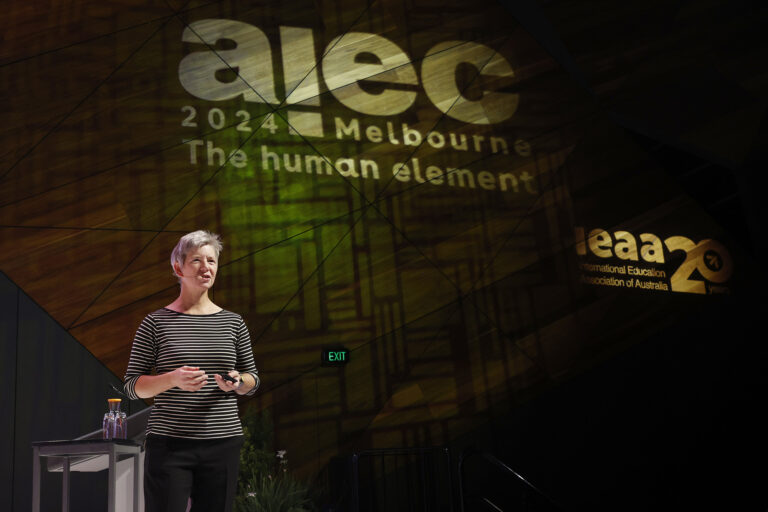
A record number of over 1,900 practitioners, teaching staff, researchers, policymakers, and other stakeholders met at the Melbourne Convention and Exhibition Centre (MCEC) from October 22 to 25 for the annual Australian International Education Conference (AIEC).
The conference is a major opportunity to learn about industry trends and developments, and to network with Australian and international colleagues.
This year’s attendees include Ben Carroll, Australia’s Deputy Premier of Victoria and Minister for Education; India’s Minister of Education, The Honourable Shri Dharmendra Pradhan, J. Prospero E. de Vera III, chairman of the board of regents of the University of the Philippines; and Abbas Nazari, the bestselling author who escaped the Taliban in Afghanistan as a child.
Discussions centred heavily around the theme “the human element.” It emphasised the personal connections, community engagement, cultural understanding, and shared in-person events that mark a student’s international education journey.
How AIEC highlights the international student voice
Whether it was sharing insights on the benefits of attending a diverse university or cost-of-living pressures, international students took to AIEC to voice their concerns and highlight the opportunities they experienced during their time in Australia.
During the plenary session titled “The human element – navigating life and learning as an international student,” several international students shared their unique stories about studying in Victoria, including how their time here had shaped their personal growth, academic pursuits, and future goals.
“The conversations were so genuine and inspiring – it was clear that people truly care about supporting international students,” writes Jessica Ji, one of the speakers. Ji, who hails from China, is currently pursuing her Bachelor of Pharmaceutical Sciences at Monash University.
Meanwhile, Ruvarashe Mandizha, a Zimbabwe citizen who is currently a nursing student at the Australian Catholic University, highlighted her fruitful time during a café session on “Careers and Employability.”
“I was thrilled to share my experiences with a number of delegates – thank you for your genuine interest in understanding the international student experience in Melbourne,” writes Mandizha. “Being able to share my story and contribute to meaningful change in this space is something I’m deeply passionate about. Here’s to more conversations that make a difference!”
Between January 2024 to July 2024, Australia recorded 943,977 international student enrolments. The year saw a record high of 420,751 new student commencements in July.
But analysts expect that figure to drop drastically. One major factor contributing to that is the Australian government’s cap on the admission of new international students to 270,000, amounting to nearly 20,000 fewer students.
“There’s so much uncertainty and change facing international students right now,”said Joanna Storti, Director of Partnerships and External Relations at IDP, the world’s largest student placement company.
In her speech, Stroti highlighted the key problem international students in Australia were facing: not getting a say in what was happening in the policy space.
Australia’s education landscape has evolved over the past year. Between exciting new offerings like Adelaide University and changes to the overall student application procedures, students and institutions alike have had to adapt their approaches to either offering or pursuing their studies in the Land Down Under.

The panel “Managing multi-country portfolios and staying human” explored customised marketing approaches that resonate on a personal level with diverse audiences. Source: Hybrid
Key topics discussed during AIEC 2024
To address these challenges and opportunities, plenaries and sessions at the conference explored “the human element.”
As part of the student recruitment and marketing insights discussion, Emma Talbot, Director of Asia-Pacific for Hybrid, a specialist partner for education, spoke on managing multi-country portfolios and staying human.
Marketing universities to international students often requires balancing global marketing campaigns with localised, student-centric content that speaks directly to the unique aspirations, cultures, and educational objectives of students from different geographical areas.
To ensure every interaction is as relevant and impactful as possible, data-driven insights and to-scale management solutions are necessary — as well as a commitment to foster genuine connections and engagement.
“It is an opportunity for us to remember that higher education is one of the biggest choices and purchases that people make,” says Talbot. “Connecting with audiences on a human level as technology advances has never been more important.”
Partnerships and collaborations across institutions and countries will play an important role in navigating the future of international education in Australia too.
One example is the work done by the Transnational Education (TNE) stakeholder reference group.
The group includes a range of participants from government bodies, universities, vocational education and training (VET) providers, and edtech companies that focus on developing flexible and adaptable education models. One such model is what the group is named after: TNE.
TNE refers to the delivery of education offshore through partnerships, foreign campuses, or online or hybrid programmes.
This serves as an exception to the Australian government’s international student cap rule, allowing education institutions an alternative way to expand and diversify their intake.
One such TNE example is the partnership between Australia and India.
The Indian Express reveals that 122,202 Indian students were enrolled in programmes in Australia in 2024, and in 2023, India was the second-largest source country for international student enrolments in Australia.
“We are opening new chapters in education, emphasising the need to equip students with essential skills for the future,” said India’s Minister of Education, The Honourable Shri Dharmendra Pradhan, during one of AIEC’s plenary speeches.
In his speech, Pradhan also touches on the Mechanism for the Mutual Recognition of Qualifications signed between India and Australia — a deal that means Indian students obtaining a degree from an Australian university will have that degree recognised in India for the purposes of continuing higher education.
It is one of the most comprehensive arguments that India has with any other country encompassing education and skill qualification.
“This will ensure the smooth mobility of students and professionals between our lessons,” said Pradhan. “With unity and determination, we will build a brighter future for generations to come.”









